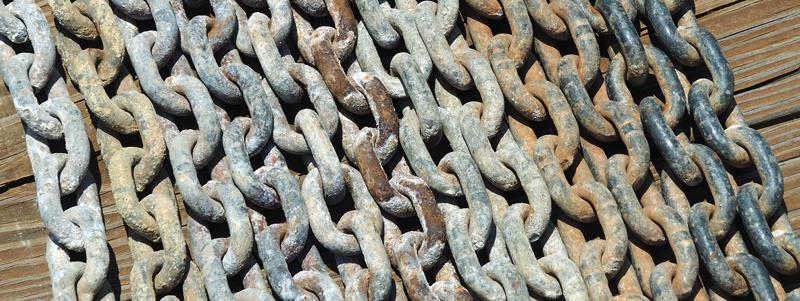
Updating your anchor chain
by SV Crystal Blues 19 Jul 2018 06:47 UTC

Anchor Chain © SV Crystal Blues
Looks fairly grungy doesn't it? This was the state of our anchor chain when we replaced it last month. Yes, we did consider having it re-galvanised, however it appears that many galvanising businesses nowadays don't want to handle chain, and don't have the correct equipment to spin it as it leaves the galvanising bath - the result is usually links welded together by excess zinc. During my search for galvanizing businesses on the US east coast, I discovered a really useful text, written by someone who worked in the galvanising industry and who was also a sailor - download it here.
A Hard Working Life
Anchor chain works hard, we consider it our most important first line of insurance. Our old chain was purchased new in 2002, 400 feet (yep) of 3/8 inch ISO size chain, heat treated to high tensile standards. Here in the USA they call it G40 ISO chain - the G40 referring to the high tensile nature and the ISO defining the link shape and size. It's actually stronger than standard 1/2 inch chain, but of course it's much lighter and takes up less space in the chain locker than 1/2 inch chain would. Download the USA specifications and chain manufacturing standards here.
By 2007 it had done a lot of work, and was regalvanised in Sarawak (Northern Borneo), where the hot chain came out of the bath and was thrown around by well intentioned workers to keep the links from sticking together. Then they hang it to cool, and the excess zinc ran down the chain to form large dimples on the end of each link - dimples just big enough to jam in the hawse pipe that lead to our chain locker. Damn.
So we spent several days grinding off the excess dimples to ensure the chain would run freely through the hawse pipe.
Then, in Thailand in 2014, we shipped it off to Bangkok to be galvanised again. That time it came back looking great, however the last four years have been tough, with reefy anchorages through Asia and across the Indian Ocean, not to mention fairly tough anchoring in Ascension Island plus all those reefy places in the Caribbean. Then a year on the US coast, the Bahama, Cuba - really, this chain had traveled well and worked hard. Given the lack of galvanising services we decided to invest in new chain.
In Australia we would buy only chain manufactured by PWB Anchor, while here in the USA we wanted Acco / Peerless chain, manufactured in the USA. Imported Chinese chain is cheaper, but we simply don't trust it. An hour or so on the web revealed a huge variation in price - West Marine wanted $6.39 per foot for the Acco chain, while Defender offered the same product at $3.80 per foot. In the end we purchased from the West Marine outlet in Deltaville, who price matched the offer from Defender - a huge discount. The new 400 foot length was delivered to the store within 48 hours in a drum, strapped on a fork lift pallet.
Out with the old, in with the new
We borrowed a friend's truck to pick up the loaded pallet, which weighed in at around 660 pounds. Back in Reedville we were able to back the truck down to the dock, then slowly unload the chain from the drum by hand and drag it down the dock to the boat.
Eventually we moved one end over the bow roller and fed it down through the windlass system into the chain locker and tied off the bitter end. From there the windlass did half the work, while Ley fed the new chain over the edge of the dock at the bow of the boat.
Hot and heavy work, compounded by the need to drag the old chain back along the dock and lift it into another truck the dame day - we'd donated it to the local Smith Point Sea Rescue group, who promptly and happily sent a truck to collect it.
This article has been provided by the courtesy of SV Crystal Blues.